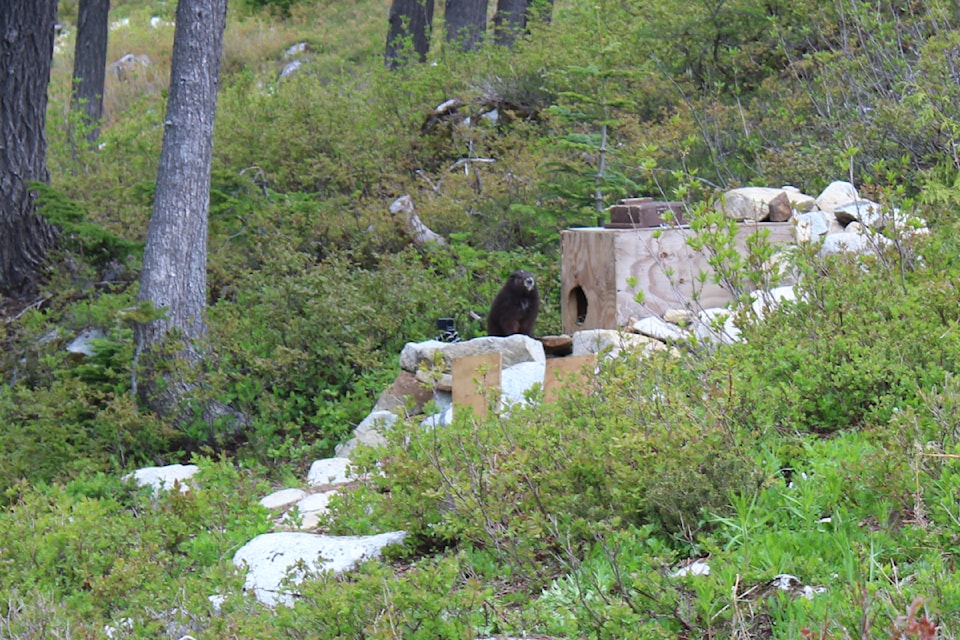The wild population of Canada's most endangered mammal, the Vancouver Island marmot, is anticipated to exceed 350 by the end of the summer thanks to the Marmot Recovery Foundation's captive-breeding efforts.
It may not seem like many, but 21 years ago the wild population had dropped to a count of fewer than two dozen.
Seeing the declining trend as early as the late-'90s, a genetic lifeboat was formed with 31 males and 25 females. These marmots were spread to five sites, including the Calgary and Toronto zoos, the Mountain View Conservation Centre and the Tony Barrett Mt. Washington Marmot Recovery Centre, run by the Marmot Recovery Foundation. There, the marmots were bred in captivity to regain their numbers and save the species from disappearing forever.
This summer, the foundation will be releasing 60 captive-bred marmots, all one or two years old, which will be joining the estimated 303 in the wild being followed through a mix of radio-telemetry tags and traditional tracking.
Adam Taylor, the foundation's executive director, said the population, while still critically endangered, is "trending in the right direction."
"At 300 individuals we're still talking about a critically endangered species, the most endangered mammal in Canada. To put that in perspective there's several thousand giant pandas, there's 600-800 mountain gorillas, so definitely still a critically endangered species. Still in desperate need of recovery effort."
As a species, Taylor said the marmots are full of character. Parents have litters of one to five pups every other year, taking a break on the interm years to recover from the taxing birthing process.
"As young marmots you'll see them run up to their parents and boop noses and play and wrestle. Every marmot is a little bit different, some are shy and you don't really see [them], some are incredibly curious and are out and exploring around their nest boxes within a few minutes."
On June 24, the foundation released its first six marmots of the year at the alpine ski hills of Mt. Washington – about a tenth of the planned releases for the season. A year's release depends on the previous year's breeding efforts, with a typical summer preparing 20 to 30 marmots for release.
The animals, no bigger than a house cat, let out shrill chirps reminiscent of a low battery on a fire alarm as they were carried across the ski hill in covered cages on the backs of volunteers. Once they reached the larger wooden nest box enclosure, members of the recovery foundation connected the cages and removed the covering, prompting the marmots to seek refuge in the dark comfort of the enclosure. Once all six animals were in together, the door to freedom was opened.
The marmots were cautious. This was the first time they were outside beyond the enclosures on the side of the recovery foundation's building with the curated rocks and dirt that they grew up with.
It took a few minutes before the first bravely stuck its head outside – sniffing the ground then retreating back. As time passed, more marmots got the courage to explore, climbing on top and playing with each other.
"It's really incredible how fast the Vancouver Island marmots are able to adjust to life in the wild," Taylor said. "It's pretty common for us to release a marmot that has spent its entire life in captivity out into the wild and see it eating natural vegetation within 30 minutes. Sometimes it takes them a few hours, almost always within a day they're eating natural vegetation and exploring the area around their borrow."
Eventually the marmots left for the network of burrows around the slope. With any luck, they will successfully integrate into the nearby colony. Some, in time, may even venture further, making the dangerous trek across the mountain to join another Strathcona colony.
According to Kevin Gourlay, the foundation's field coordinator, young males between two and three years old are most likely to disperse from their home colony, but they have also tracked young females making the journey.
The broader Strathcona population has about 130-150 marmots spread throughout, while Mt. Washington is home to about 32.
The Island marmots prefer cleared alpine territory such as slopes post-avalanche. With human intervention, the ski slopes of Mt. Washington serve as an ideal place for the marmots to roam during the summer. In the winter, they sleep deep underneath the ground – unaware and unbothered by the skiers racing overtop of them.
"Vancouver Island marmots are one of the few animals that hibernate longer than they're awake," Taylor said. "A species that's asleep for seven months a year and only awake for five months of the year. When they're in hibernation, it is serious hibernation. They're probably two to four metres underground, another metre to four metres of snow above ground."
Over the summer, the foundation plans to release another 15 marmots at Mt. Washington. The remainder will be distributed to existing Island colonies, including the Nanaimo Lakes population, which makes up about half of all wild Vancouver Island marmots.
"There's a number of reasons it's really important for us to recover the Vancouver Island marmots. For starters, this is the only endemic mammal species to British Columbia, one of only four endemic mammal species in Canada. If we don't save the marmot, nobody else is going to," Taylor said.
The recovery foundation is largely funded by donations, which covers about 75 per cent of the group's work, while the remainder is from grants.
"Unfortunately there are a lot of species in Canada and around the world that are in trouble," Taylor said. "Populations are declining and we need to blaze a path showing the kind of science that's possible, the kind of recovery action that's possible – to demonstrate even our most endangered species can be successfully recovered if we're willing to commit the resources and the time to do it."
To find out more, people can visit the Marmot Recovery Foundation's website at http://marmots.org.

